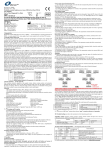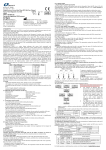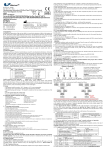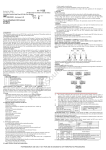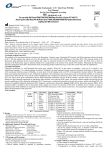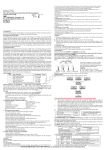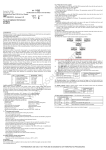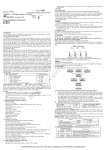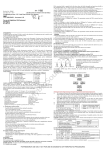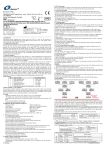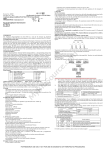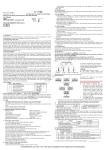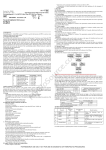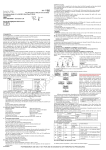Download (MRSA) Real Time PCR Kit
Transcript
For use with LightCycler1.0/2.0 Instrument Attention: A. During the incubation, make sure the tube is not open. Since the vapor will volatilize into the air and may cause contamination if the sample is positive. B. The extraction sample should be used in 3 hours or stored at -20°C for one month. C. DNA extraction kits are available from various manufacturers. You may use your own extraction systems or the commercial kit based on the yield. For the DNA extraction, please comply with the manufacturer’s instructions. 9.2 Internal Control It is necessary to add internal control (IC) in the reaction mix. Internal Control (IC) allows the user to determine and control the possibility of PCR inhibition. Add the internal control (IC) 1μl/rxn and the result will be shown in the 560nm. 9.3 Quantitation The kit can be used for quantitative or qualitative real-time PCR. For performance of quantitative real-time PCR, Standard dilutions must prepare first as follows. Molecular Grade Water is used for dilution. The step of dilution is not needed for performance of qualitative real-time PCR. Take positive control as the starting high standard in the first tube. Respectively pipette 36ul of Molecular Grade Water into next three tubes. Do three dilutions as the following figures: To generate a standard curve on the real-time system, all four dilution standards should be used and defined as standard with specification of the corresponding concentrations. Attention: A. Mix thoroughly before next transfer. B. The positive control contains high concentration of the target DNA. Therefore, be careful during the dilution in order to avoid contamination. 9.4 PCR Protocol The Master Mix volume for each reaction should be pipetted as follows: M yB io So ur 1. Intended Use Methicillin-resistant Staphylococcus Aureus(MRSA) real time PCR kit is used for the detection of MRSA in stool, sputum, C.S.F., urine, gargle, food or water samples by the real time PCR systems. 2. Principle of Real-Time PCR The principle of the real-time detection is based on the fluorogenic 5’nuclease assay. During PCR reaction, the DNA polymerase cleaves the probe at the 5’ end and separates the reporter dye from the quencher dye only when the probe hybridizes to the target DNA. This cleavage results in the fluorescent signal generated by the cleaved reporter dye, which is monitored real-time by the PCR detection system. The PCR cycle at which an increase in the fluorescence signal is detected initially (Ct) is proportional to the amount of the specific PCR product. Monitoring the fluorescence intensities during Real Time allows the detection of the accumulating product without having to re-open the reaction tube after the amplification. 3. Product Description Methicillin-resistant Staphylococcus aureus (MRSA) is a bacterium responsible for difficult-to-treat infections in humans. It may also be referred to as multiple-resistant Staphylococcus aureus or oxacillin-resistant Staphylococcus aureus (ORSA). MRSA is especially troublesome in hospital-associated (nosocomial) infections. In hospitals, patients with open wounds, invasive devices, and weakened immune systems are at greater risk for infection than the general public. Hospital staff who do not follow proper sanitary procedures may transfer bacteria from patient to patient. MRSA real time PCR kit contains a specific ready-to-use system for the detection of MRSA by polymerase chain reaction (PCR) in the real-time PCR system. The master contains reagents and enzymes for the specific amplification of MRSA DNA. Fluorescence is emitted and measured by the real time systems´ optical unit during PCR. The detection of amplified MRSA DNA fragment is performed in fluorimeter channel 530nm with the fluorescent quencher BHQ1. DNA extraction buffer is available in the kit. In addition, the kit contains a system to identify possible PCR inhibition by measuring the 560nm fluorescence of the internal control (IC). An external positive control (1×107 copies/ml) is supplied allows the determination of the gene load. For further information, please refer to section 9.3 Quantitation. 4. Kit Contents Ref. Type of Reagent Presentation 25rxns 1 DNA Extraction Buffer 2 vials, 1.5ml 2 MRSA Reaction Mix 1 vial, 450μl 3 PCR Enzyme Mix 1 vial, 12μl 4 Molecular Grade Water 1 vial, 400μl 5 Internal Control (IC) 1 vial, 30μl 6 MRSA Positive Control(1×107 copies/ml) 1 vial, 30μl Analysis sensitivity: 5×103 copies/ml ; LOQ:1×104~1×108 copies/ml. Note: Analysis sensitivity depends on the sample volume, elution volume, nucleic acid extraction methods and other factors .If you use the DNA extraction buffer in the kit, the analysis sensitivity is the same as it declares. However, when the sample volume is dozens or even hundreds of times greater than elution volume by some concentrating method, it can be much higher. 5. Storage om MBS598058 - Instrument I, II .c (For Research Use Only In USA & China) Methicillin-resistant Staphylococcus Aureus (MRSA) Real Time PCR Kit User Manual ce Revision No.: ZJ0009 Issue Date: Jul 1st, 2015 in a table centrifuge. 3) Incubate the tube for 10 minutes at 100°C. 4) Centrifuge the tube at 13000rpm for 5 minutes. The supernatant contains the DNA extracted and can be used for PCR template. 9.1.2 Sputum sample 1) Trypsin digestive Solution preparation Add 10g trypsin to 200ml sterile purified water and mix thoroughly. Adjust the PH value to 8.0 with 2 % N a O H s o l u t i o n . A d d 2 m L 2 5 m m o l / L C a C l 2 , mix thoroughly and store at 4℃. Please incubate at 37℃ for 10 minutes before use. 2) Estimate the volume of sputum and add partes aequales of trypsin digestive solution then vortex vigorously. Set at room temperature for 30 minutes. Transfer 0.5ml mixture to a new tube. Centrifuge the tube at 13000rpm for 5 minutes, carefully remove and discard supernatant from the tube without disturbing the pellet. 3) Add 1.0ml normal saline. Resuspend the pellet with vortex vigorously. Centrifuge at 13000rpm for 5 minutes. Carefully remove and discard supernatant from the tube without disturbing the pellet. 4) Repeat step 3) 5) Add 50μl DNA extraction buffer, close the tube then resuspend the pellet with vortex vigorously. Spin down briefly in a table centrifuge. 6) Incubate the tube for 10 minutes at 100°C. 7) Centrifuge the tube at 13000rpm for 10 minutes. The supernatant contains the DNA extracted and can be used for PCR template. 9.1.3 C.S.F, urine, gargle, water samples 1) Take3ml sample to a tube, Centrifuge the tube at 13000rpm for 2 minutes, carefully remove and discard supernatant from the tube without disturbing the pellet. 2) Add 100μl DNA extraction buffer, close the tube then resuspend the pellet with vortex vigorously. Spin down briefly in a table centrifuge. 3) Incubate the tube for 10 minutes at 100°C. 4) Centrifuge the tube at 13000rpm for 5 minutes. The supernatant contains the DNA extracted and can be used for PCR template. 9.1.4 Other samples 1) Pipet 100μl sample to a new 0.5ml tube, add 100μl DNA extraction buffer, closed the tube then vortex for 10 seconds. Spin down briefly in a table centrifuge. 2) Incubation the tube for 10 minutes at 100°C. 3) Centrifuge the tube at 13000rpm for 10 minutes. The supernatant contains the extracted DNA and can used for the template of the PCR. • All reagents should be stored at -20°C. Storage at +4°C is not recommended. • All reagents can be used until the expiration date indicated on the kit label. • Repeated thawing and freezing (>3x) should be avoided, as this may reduce the sensitivity of the assay. • Cool all reagents during the working steps. • Reaction mix should be stored in the dark. 6. Additionally Required Materials and Devices • Biological cabinet • Real time PCR system • Vortex mixer • Real time PCR reaction tubes/plates • Cryo-container • Pipets (0.5μl – 1000μl) • Sterile filter tips for micro pipets • Sterile microtubes • Disposable gloves, powderless • Biohazard waste container • Refrigerator and Freezer • Tube racks • Desktop microcentrifuge for “eppendorf” type tubes (RCF max. 16,000 x g) Warnings and Precaution • Carefully read this instruction before starting the procedure. • For in vitro diagnostic use only. • This assay needs to be carried out by skilled personnel. • Clinical samples should be regarded as potentially infectious materials and should be prepared in a laminar flow hood. • This assay needs to be run according to Good Laboratory Practice. • Do not use the kit after its expiration date. • Avoid repeated thawing and freezing of the reagents, this may reduce the sensitivity of the test. • Once the reagents have been thawed, vortex and centrifuge briefly the tubes before use. • Quickly prepare the reaction mix on ice or in the cooling block. • Set up two separate working areas: 1) Isolation of the RNA/ DNA and 2) Amplification/ detection of amplification products. • Pipets, vials and other working materials should not circulate among working units. • Use always sterile pipette tips with filters. • Wear separate coats and gloves in each area. 8. Sample Collection, Storage and transportation • Collect samples in sterile tubes; • Specimens can be extracted immediately or frozen at -20°C to -80°C. • Transportation of clinical specimens must comply with local regulations for the transport of etiologic agents 9. Procedure 9.1 DNA-Extraction DNA extraction buffer is supplied in the kit. Attention: please thaw the buffer thoroughly and mix the buffer well before use because it contains insoluble particles. It’s better to use commercial kits for nucleic acid extraction. 7. 9.1.1 Stool or food sample 1) Take about 50mg stool or 500mg food samples to a tube; add 1.0ml normal saline then vortex vigorously. Centrifuge the tube at 13000rpm for 2 minutes, carefully remove and discard supernatant from the tube without disturbing the pellet. 2) Add 100μl DNA extraction buffer, close the tube then resuspend the pellet with vortex vigorously. Spin down briefly ※PCR system without 560nm channel may be treated with 1μl Molecular Grade Water instead of 1μl IC. 1) The volumes of Reaction Mix and Enzyme Mix per reaction multiply with the number of samples, which includes the number of the controls,standards and sample prepared. Molecular Grade Water is used as the negative control. For reasons of unprecise pipetting, always add an extra virtual sample. Mix the master mix completely then spin down briefly in a centrifuge. 2) Pipet 18μl Master Mix with micropipets of sterile filter tips to each Real time PCR reaction plate/tube. Then separately add 2μl DNA sample, positive and negative controls to different reaction plate/tubes. Immediately close the plate/tubes to avoid contamination. 3) Spin down briefly in order to collect the Master Mix in the bottom of the reaction tubes. 4) Perform the following protocol in the instrument: 37°C for 2min 1cycle Selection of fluorescence channels 94°C for 2min 1cycle 530nm Target Nucleic Acid 93°C for 5sec, 60°C for 30sec 560nm IC 40cycles ( Fluorescence measured at 60°C) 10.Threshold setting: Choose Arithmetic as back ground and none as Noise Band method, then adjust the Noise band just above the maximum level of molecular grade water, and adjust the threshold just under the minimum of the positive control. 11.Calibration for quantitative detection: Input each concentration of standard controls at the end of run, and a standard curve will be automatically formed. 12.Quality control: Negative control, positive control, internal control and QS curve must be performed correctly, otherwise the sample results is invalid. Channel Crossing point value Control 530nm 560nm Molecular Grade Water Blank 25~35 Positive Control(qualitative assay) ≤35 —— QS(quantitative detection) Correlation coefficient of QS curve≤-0.98 13. Data Analysis and Interpretation :The following results are possible: Crossing point value Result Analysis 530nm 560nm 1# Blank 25~35 Below the detection limit or negative 2# Positive; and the software displays the quantitative value ≤35 —— 3# 25~35 Re-test; If it is still 35~40, report as 1# 35~40 4# Blank Blank PCR Inhibition; No diagnosis can be concluded. For further questions or problems,please contact our technical support FOR RESEARCH USE ONLY. NOT FOR USE IN DIAGNOSTIC OR THERAPEUTIC PROCEDURES. For use with ABI Prism®7000/7300/7500/7900/Step One Plus; iCycler iQ™4/iQ™5; Smart Cycler II;Bio-Rad CFX 96;Rotor Gene™6000; Mx3000P/3005P;MJ-Option2/Chromo4; LightCycler®480 Instrument M yB io So ur 1. Intended Use Methicillin-resistant Staphylococcus Aureus(MRSA) real time PCR kit is used for the detection of MRSA in stool, sputum, C.S.F., urine, gargle, food or water samples by the real time PCR systems. 2. Principle of Real-Time PCR The principle of the real-time detection is based on the fluorogenic 5’nuclease assay. During PCR reaction, the DNA polymerase cleaves the probe at the 5’ end and separates the reporter dye from the quencher dye only when the probe hybridizes to the target DNA. This cleavage results in the fluorescent signal generated by the cleaved reporter dye, which is monitored real-time by the PCR detection system. The PCR cycle at which an increase in the fluorescence signal is detected initially (Ct) is proportional to the amount of the specific PCR product. Monitoring the fluorescence intensities during Real Time allows the detection of the accumulating product without having to re-open the reaction tube after the amplification.. 3. Product Description Methicillin-resistant Staphylococcus aureus (MRSA) is a bacterium responsible for difficult-to-treat infections in humans. MRSA is especially troublesome in hospital-associated (nosocomial) infections. In hospitals, patients with open wounds, invasive devices, and weakened immune systems are at greater risk for infection than the general public. Hospital staff who do not follow proper sanitary procedures may transfer bacteria from patient to patient. MRSA real time PCR kit contains a specific ready-to-use system for the detection of both gene mecA and gene nuc by polymerase chain reaction (PCR) in the real-time PCR system. The master contains reagents and enzymes for the specific amplification of mecA gene and nuc gene DNA. Fluorescence is emitted and measured by the real time systems´ optical unit during PCR. The detection of amplified mecA gene DNA fragment is performed in fluorimeter channel FAM with the fluorescent quencher BHQ1. The detection of amplified nuc gene DNA fragment is performed in fluorimeter channel HEX/VIC/JOE with the fluorescent quencher BHQ1. DNA extraction buffer is available in the kit. In addition, the kit contains a system to identify possible PCR inhibition by measuring the the Cal Red 610/ROX/TEXAS RED fluorescence of the internal control (IC). An external positive control (1×107 copies/ml) is supplied allows the determination of the gene load. 4. Kit Contents Ref. Type of Reagent Presentation 25rxns 1 DNA Extraction Buffer 2 vials, 1.5ml 2 MRSA Reaction Mix 1 vial, 950μl 3 PCR Enzyme Mix 1 vial, 12μl 4 Molecular Grade Water 1 vial, 400μl 5 Internal Control (IC) 1 vial, 30μl 7 6 MRSA Positive Control(1×10 copies/ml) 1 vial, 30μl Analysis sensitivity: 5×103 copies/ml Note: Analysis sensitivity depends on the sample volume, elution volume, nucleic acid extraction methods and other factors .If you use the DNA extraction buffer in the kit, the analysis sensitivity is the same as it declares. However, when the sample volume is dozens or even hundreds of times greater than elution volume by some concentrating method, it can be much higher. 5. Storage • All reagents should be stored at -20°C. Storage at +4°C is not recommended. • All reagents can be used until the expiration date indicated on the kit label. • Repeated thawing and freezing (>3x) should be avoided, as this may reduce the sensitivity of the assay. • Cool all reagents during the working steps. • Reaction mix should be stored in the dark. 6. Additionally Required Materials and Devices • Biological cabinet • Real time PCR system • Vortex mixer • Real time PCR reaction tubes/plates • Cryo-container • Pipets (0.5μl – 1000μl) • Sterile filter tips for micro pipets • Sterile microtubes • Disposable gloves, powderless • Biohazard waste container • Refrigerator and Freezer • Tube racks • Desktop microcentrifuge for “eppendorf” type tubes (RCF max. 16,000 x g) om MBS598058 - Instrument III, IV .c User Manual ce Revision No.: ZJ0009 Issue Date: Jul 1st, 2015 (For Research Use Only In USA & China) Methicillin-resistant Staphylococcus Aureus (MRSA) Real Time PCR Kit vigorously. Centrifuge the tube at 13000rpm for 2 minutes, carefully remove and discard supernatant from the tube without disturbing the pellet. 2) Add 100μl DNA extraction buffer, close the tube then resuspend the pellet with vortex vigorously. Spin down briefly in a table centrifuge. 3) Incubate the tube for 10 minutes at 100°C. 4) Centrifuge the tube at 13000rpm for 5 minutes. The supernatant contains the DNA extracted and can be used for PCR template. 9.1.2 Sputum sample 1) Trypsin digestive Solution preparation Add 10g trypsin to 200ml sterile purified water and mix thoroughly. Adjust the PH value to 8.0 with 2 % N a O H s o l u t i o n . A d d 2 m L 2 5 m m o l / L C a C l 2 , mix thoroughly and store at 4℃. Please incubate at 37℃ for 10 minutes before use. 2) Estimate the volume of sputum and add partes aequales of trypsin digestive solution then vortex vigorously. Set at room temperature for 30 minutes. Transfer 0.5ml mixture to a new tube. Centrifuge the tube at 13000rpm for 5 minutes, carefully remove and discard supernatant from the tube without disturbing the pellet. 3) Add 1.0ml normal saline. Resuspend the pellet with vortex vigorously. Centrifuge at 13000rpm for 5 minutes. Carefully remove and discard supernatant from the tube without disturbing the pellet. 4) Repeat step 3) 5) Add 50μl DNA extraction buffer, close the tube then resuspend the pellet with vortex vigorously. Spin down briefly in a table centrifuge. 6) Incubate the tube for 10 minutes at 100°C. 7) Centrifuge the tube at 13000rpm for 10 minutes. The supernatant contains the DNA extracted and can be used for PCR template. 9.1.3 C.S.F, urine, gargle, water samples 1) Take3ml sample to a tube, Centrifuge the tube at 13000rpm for 2 minutes, carefully remove and discard supernatant from the tube without disturbing the pellet. 2) Add 100μl DNA extraction buffer, close the tube then vortex for 10 seconds. Spin down briefly in a table centrifuge. 3) Incubate the tube for 10 minutes at 100°C. 4) Centrifuge the tube at 13000rpm for 5 minutes. The supernatant contains the DNA extracted and can be used for PCR template. 9.1.4 Other samples 1) Pipet 100μl sample to a new 0.5ml tube, add 100μl DNA extraction buffer, closed the tube then vortex for 10 seconds. Spin down briefly in a table centrifuge. 2) Incubation the tube for 10 minutes at 100°C. 3) Centrifuge the tube at 13000rpm for 10 minutes. The supernatant contains the extracted DNA and can used for the template of the PCR. Attention: A. During the incubation, make sure the tube is not open. Since the vapor will volatilize into the air and may cause contamination if the sample is positive. B. The extraction sample should be used in 3 hours or stored at -20°C for one month. C. DNA extraction kits are available from various manufacturers. You may use your own extraction systems or the commercial kit based on the yield. For the DNA extraction, please comply with the manufacturer’s instructions. 9.2 Internal Control It is necessary to add internal control (IC) in the reaction mix. Internal Control (IC) allows the user to determine and control the possibility of PCR inhibition. Add the internal control (IC) 1μl/rxn and the result will be got in the Cal Red 610 channel. 9.3 PCR Protocol The Master Mix volume for each reaction should be pipetted as follows: 7. Warnings and Precaution • Carefully read this instruction before starting the procedure. • For in vitro diagnostic use only. • This assay needs to be carried out by skilled personnel. • Clinical samples should be regarded as potentially infectious materials and should be prepared in a laminar flow hood. • This assay needs to be run according to Good Laboratory Practice. • Do not use the kit after its expiration date. • Avoid repeated thawing and freezing of the reagents, this may reduce the sensitivity of the test. • Once the reagents have been thawed, vortex and centrifuge briefly the tubes before use. • Quickly prepare the reaction mix on ice or in the cooling block. • Set up two separate working areas: 1) Isolation of the RNA/ DNA and 2) Amplification/ detection of amplification products. • Pipets, vials and other working materials should not circulate among working units. • Use always sterile pipette tips with filters. • Wear separate coats and gloves in each area. 8. Sample Collection, Storage and transportation • Collect samples in sterile tubes; • Specimens can be extracted immediately or frozen at -20°C to -80°C. • Transportation of clinical specimens must comply with local regulations for the transport of etiologic agents 9. Procedure 9.1 DNA-Extraction DNA extraction buffer is supplied in the kit. Attention: please thaw the buffer thoroughly and mix the buffer well before use because it contains insoluble particles. It’s better to use commercial kits for nucleic acid extraction. OR ※PCR system without Cal Red 610/ROX/TEXAS RED channel may be treated with 1μl Molecular Grade Water instead of 1μl IC. 1) The volumes of Reaction Mix and Enzyme Mix per reaction multiply with the number of samples, which includes the number of the controls,standards and sample prepared. Molecular Grade Water is used as the negative control. For reasons of unprecise pipetting, always add an extra virtual sample. (n: the number of reaction ).Mix completely then spin down briefly in a centrifuge. 2) Pipet 36μl (22.5μl for SmartCycer II) Master Mix with micropipets of sterile filter tips to each Real time PCR reaction plate/tube. Then separately add 4μl (2.5μl for SmartCycer II) DNA sample, positive and negative controls to different reaction plate/tubes. Immediately close the plate/tubes to avoid contamination. 3) Spin down briefly in order to collect the Master Mix in the bottom of the reaction tubes. 4) Perform the following protocol in the instrument: 37°C for 2min 1cycle Selection of fluorescence channels 94°C for 2min 1cycle FAM mecA 93°C for 15sec, 60°C for 1min HEX/VIC/JOE nuc 40cycles ( Fluorescence measured at 60°C) Cal Red 610/ROX/TEXAS RED IC 5) If you use ABI Prism® system, please choose “none” as passive reference and quencher. 10. Threshold setting: just above the maximum level of molecular grade water. 11.Quality control: Negative control, positive control, internal control performed correctly, otherwise the sample results is invalid. Channel Ct value Control FAM HEX/VIC/JOE Molecular Grade Water UNDET UNDET Positive Control(qualitative assay) ≤35 ≤35 Cal Red 610 25~35 —— 12. Data Analysis and Interpretation :The following results are possible: Ct value Result Analysis FAM HEX Cal Red 610 1# UNDET UNDET 25~35 Below the detection limit or negative 2# UNDET MecA gene positive; but not SA ≤35 —— 3# UNDET SA positive; but not MRSA strain ≤35 —— 4# MRSA positive ≤35 ≤35 —— 5# 25~35 Re-test; If it is still 35~40, report as 1# 35~40 6# UNDET UNDET PCR Inhibition; No diagnosis can be concluded. For further questions or problems,please contact our technical support 9.1.1 Stool or food sample 1) Take about 50mg stool or 500mg food samples to a tube; add 1.0ml normal saline then vortex and QS curve must be FOR RESEARCH USE ONLY. NOT FOR USE IN DIAGNOSTIC OR THERAPEUTIC PROCEDURES.


